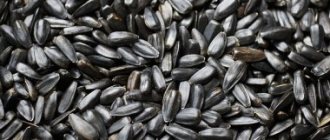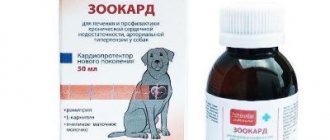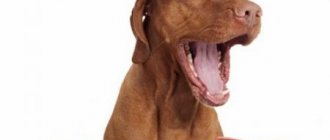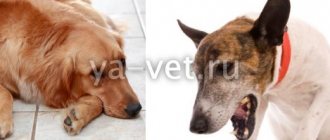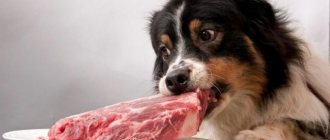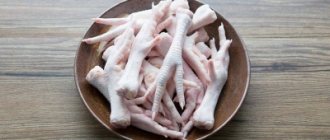Many owners of four-legged pets firmly believe that pig bones should be in the diet of any dog. However, is it possible to feed them without fear?
This article will tell you in detail about the harm bones can cause, in what form they can be given and in what form they cannot, and also what to do if the dog has eaten prohibited treats and is not feeling well.
Why not?
Any dog will happily eat pork and any other bones. That is why the owner must carefully monitor what goes into his pet’s bowl and know what problems arise after an incorrectly selected diet.
Feeding pig leftovers is not recommended for the following reasons:
- Uncooked pork may contain parasite eggs that can be passed on to the dog. The most common are pork tapeworm, trichinosis and echinococcosis.
- Pork is a fatty product. Regularly eating bones with residual meat and fat can cause health problems for your dog.
- Bones can cause digestive problems.
Possible mechanical damage to the stomach should also be taken into account. If the animal does not completely chew the bones, swallowing their sharp stumps, they can stick into the walls of the internal organs, causing bleeding and pain.
Regular use is deadly
Many are convinced that the domestic dog is a predator, and that bones are an integral part of his daily diet. We must immediately warn you that bones for dogs do more harm than good. They are too rough a product and overload the chewing muscles and jaws. The consequence of this may be a change in the bite. If they are consumed frequently, tooth enamel is inevitably damaged and there is a risk of caries and pulpitis. Poorly chewed, they can get stuck in the throat and injure it. A meat feast can end with asphyxia or life-threatening bleeding.
Particular attention should be paid to the fact that it is strictly forbidden to give boiled or other heat-treated bones.
Such food is extremely fatty and high in calories. It is very difficult for the body to digest and assimilate it. Under the influence of gastric juice, this food turns into a compacted sticky lump, which is like a dense cork. The most terrible delicacy is jellied meat. The semi-digested mass fills the intestines. Symptoms of colon blockage include constipation, diarrhea, sometimes accompanied by blood, and severe vomiting. With regular poor nutrition, the animal's metabolism is disrupted. The consequence of this is decreased gastric acidity. For this reason, solid fragments are not completely digested, but clog the stomach, forming a kind of sharp lump. If this poorly digested bone enters the small intestine, perforation will occur. The consequences of this can be fatal - peritonitis or necrosis. In case of such serious complications, only surgery is indicated. The conclusion is that frequently giving a dog bones is a crime against its long, healthy life.
Boiled or raw?
Boiled bones, no matter whether they are pork or any other, should not be given to your pet. After consumption, they accumulate in the animal’s digestive tract into a very dense mass and clog the intestines.
This can cause not only constipation, but also complete obstruction.
In severe cases, it will be impossible to solve the problem without surgery. Attention! Particularly dangerous are the bones that remain after preparing jellied meat. They should not be given under any circumstances.
Which dog breeds can be fed bones and which cannot?
It is recommended to give high quality natural bones to medium and large breeds, but only as a treat. You can give them to puppies when they change teeth, as a tasty toy.
Small breeds do not have such physical characteristics and bones are contraindicated for them. Such dogs often have problems with teeth - another reason for the disadvantage of giving a bone. The pet industry produces various artificial options for them. It is very good sometimes to give a pressed look from veins of the appropriate size. Gelatin ones are less nutritious.
How to give?
If the owner decides to ignore the rules and give his pet a pork bone, he must follow the basic rules that will reduce the likelihood of problems:
- They should be given only after the main feeding. If your dog is hungry, he may rush into the treat too much and choke or chew poorly, resulting in too large pieces going down his throat.
- Make sure that the pork bone does not have sharp edges or cuts. It would be better if it ends with cartilage on both sides.
- The smaller the dog breed, the smaller the treat should be.
- The bone must be fresh and uncooked. You should not give your pet a product of questionable freshness.
At what age can a puppy eat a bone?
Can I give my puppy bones? Only veal ones, namely the shoulder blade with cartilage, the breast bone and pseudoribs. They contain a lot of chondrin and collagen.
It is recommended to introduce it into the diet from 3 months. After the start of the process of changing teeth. They are not suitable as main food. Can be used as a toy with a pleasant taste from 2 months. It is important to ensure that there are no chips on the bone that could injure your pet. The edges should be round and not damaged. Problems can arise if the animal eats a small bone. A whole, rounded bone with remnants of cartilage and ligaments will benefit the puppy. Especially when his teeth change, he will chew on it, not the furniture.
Older individuals can be given milk from 1-2 year old bulls or calves.
What to do if you eat it?
The first thing a dog that has eaten too much pork bones and is experiencing discomfort will do is refuse to eat.
Other symptoms of intestinal damage:
- the animal moves little, avoid taking painful positions;
- when pressing on the abdomen, he experiences pain and whines;
- vomiting occurs;
- in severe cases, the pet cannot get up.
Damage to the inner walls of the digestive tract is indicated by blood in the stool or vomit.
If a dog has voluntarily eaten pork bones, the following will help prevent unwanted problems in the body:
- Diet. The animal should be put on a light diet for the next 3-4 days. Liquid food will help not overload the intestines and create optimal conditions for the release of bones.
- Movement. Active walks will improve gastrointestinal motility.
- Vaseline oil. Give 2-3 ml for a small dog, 10-12 for a medium-sized dog and 20-25 for a large dog every 12 hours. The substance will lubricate the intestinal walls and help push through stagnant food.
Important! Do not try to remove a crushed pork bone from the mouth or induce vomiting in the animal. This can lead to injury to the digestive tract.
If within 3-4 days after the dog ate too many bones, the condition did not worsen, then it was able to digest the food.
However, if the dog has lost appetite and vigor, and has stopped going to the toilet, you should consult a veterinarian. Probably, a plug formed in the intestines from what was eaten.
An enema will help cope with constipation after eating pork bones in a dog. You can perform intestinal lavage with regular tap water at a comfortable temperature (29-31 degrees).
Using a syringe, liquid is injected into the animal's rectum. Water can be replaced with Vaseline oil. For a dog weighing more than 45 kg, you will need 1 glass, for small breeds - 2-3 spoons.
If your pet cannot move independently, you should not force him to stand up or try to carry him in your arms. The animal can only be transported on a stretcher, which you can build yourself from available items.
Structure and composition of bones
From an anatomical point of view, bone is a multi-tissue organ, consisting mainly of bone tissue, and besides it, many others: adipose tissue, cartilage, hematopoiesis, etc. Each bone is covered with periosteum - a highly innervated fibrous membrane, the task of which is to protect the bone outside. Inside the joints, the bones are covered with articular cartilage. The trunk of the long and flat bones consists of a compact body, while the base of the long bones and the interior of the flat and other bones consists of spongy substance.
The compact body is a calcareous substance high in calcium phosphate, which makes bones hard, stiff and resistant to fracture. On the other hand, the spongy essence has a loose structure consisting of bony trabeculae, occupying from 15 to 25 percent of its volume. The rest is taken up by the bone marrow.
According to their structure and functions, bones are divided into:
Tubular - in the form of short or long tubes, consisting of dense and spongy substance and filled with bone marrow, which mainly performs a hematopoietic function, and the bones themselves have a supporting and protective function (tubular bones of the limbs). Can dogs have tubular bones? No, they are dangerous for a domestic dog (large, medium and small breeds), as the sharp ends can injure the walls of the stomach.
Spongy bones are covered with a compact body; they serve to attach muscles and perform a hematopoietic function.
The bones formed by ossification of tendons (patella) function as cancellous bones.
Flat bones consist of a compact substance. They have a hematopoietic and protective function (scapula, ilium).
Mostly, the bones are inorganic (50-70 percent). As a rule, these are calcium and magnesium salts - chlorides and phosphates. Therefore, it is not a valuable nutrient. Only bone marrow contains fats, proteins, carbohydrates and iron, but not in sufficient quantities to properly nourish a dog.
What to replace it with?
A dog on a natural diet must chew something regularly. This will help clean your teeth. However, you can pamper your pet no more than 2-3 times a month.
For small dogs, chicken necks, keels or backbones are suitable. Larger dogs are beef shins or forearms. For large animals like mastiffs or Great Danes, goat skulls, cow or sheep ribs, and pelvic parts.
Important! If the dog eats high-quality dry food from an industrial manufacturer, then there is no need for additional teeth cleaning.
Safe Alternative
In specialized stores you can purchase carefully processed or artificial analogues of natural cartilage and muscles.
Artificial bones for dogs – how to choose
An industrially produced treat is optimal for a dog that eats dry food. Similar cartilages are sold in all pet stores and are inexpensive. Manufacturers produce different types of artificial analogues that do not harm the health of the pet. The following bones are available for sale:
- Calcium, beneficial for tooth enamel and musculoskeletal health.
- Made from dry veins, intended for cleansing and massaging the oral cavity. This type does not cause a food reaction, so it is well suited for dogs with allergies.
- Chewable, which is given to four-legged animals only from 4 months of age.
- Gelatin, which is an additional source of collagen. These analogues are useful for pregnant and weakened individuals, as they are enriched with vitamins and minerals.
When choosing artificial cartilage, it is important to find an option suitable for your four-legged pet. Its size must correspond to the dimensions of the individual. A small cartilage can cause suffocation in a giant pet, and an artificial one that is too large can cause injuries to the jaws and teeth of small breeds.
Minced bone
Mechanically processed solid residues are obtained as a result of the production of sausage products and semi-finished meat products. It is a cheap product that owners use to feed their animals.
Dog bone mince is useless because it does not contain any beneficial substances. The particles do not enrich the four-legged body with vitamins and microelements. There are cases when pieces of minced meat accumulate in the intestines and cause constipation, which is dangerous for the pet.
Special toys
Sometimes cartilage and muscles replace toys for dogs. But pet stores sell special items that your four-legged friend can chew for health benefits. These are toys made of safe plastic or rubber in the form of bones or bird carcasses. Such items can distract your pet during periods of loneliness and clean plaque from the surface of the teeth.
Which pets are strictly contraindicated for bones?
Veterinarians do not always approve of the use of cartilage and bones. Bones are prohibited for older individuals, as they can damage already weak teeth. In addition, the solid product causes problems with the functioning of the gastrointestinal tract and leads to chronic constipation
In puppies up to 3 months old, hard parts stop the growth of canines and provoke malocclusion. The same problem may accompany the use of moslov in individuals participating in exhibitions. Using bones as a toy causes abrasion of enamel, breakage of teeth and spoils the appearance of champions.
